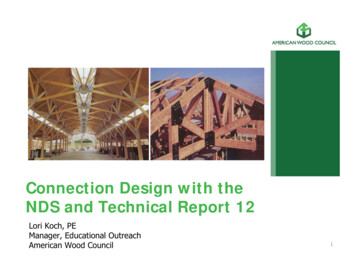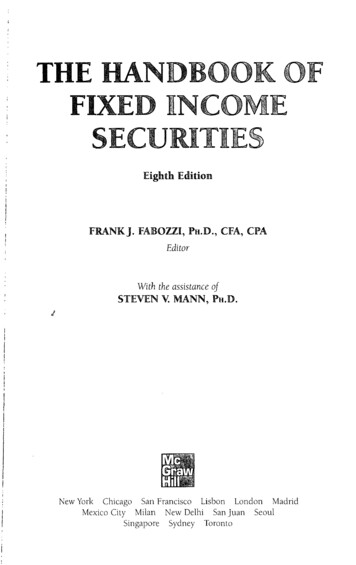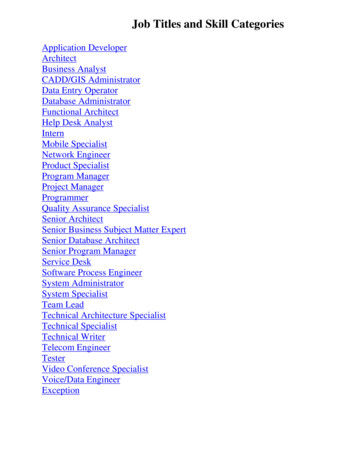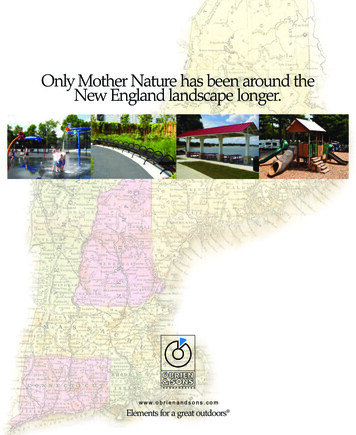
Transcription
Connection Design with theNDS and Technical Report 12Lori Koch, PEManager, Educational OutreachAmerican Wood Council1
Copyright MaterialsThis presentation is protected by US andInternational Copyright laws. Reproduction,distribution, display and use of the presentationwithout written permission of the speaker isprohibited. American Wood Council 20172
Course DescriptionThis course will feature techniques for designing connections for woodmembers utilizing AWC's 2015 National Design Specification (NDS )for Wood Construction and Technical Report 12 - General DowelEquations for Calculating Lateral Connection Values (TR12). Topics willinclude connection design philosophy and behavior, an overview ofcommon fastener types, changes in the 2015 NDS related to crosslaminated timber, and design examples per TR12.3
Learning Objectives On completion of this course, participants will:1. Be familiar with current wood member connection solutionsand applicable design requirements.2. Be familiar with Technical Report 12 and provisions forconnection design beyond NDS requirements.3. Be able to recommend fastening guidelines for wood tosteel, wood to concrete, and wood to wood connections.4. Be able to describe effects of moisture on wood memberconnections and implement proper detailing to mitigateissues that may occur.4
Outline Wood connection designphilosophy Connection behavior Serviceability challenges Connection hardware andfastening systems Connection techniques Design software Where to get moreinformation5
Basic Concepts Model wood cells as a bundle of straws Bundle is very strong parallel to axis of the strawsParallelStrongerPerpendicularLess strong6
Connecting Wood - Philosophy Wood likes compression parallel to grain makes connecting wood very easy7
Connecting Wood - Philosophy Wood likes compression parallel to grain makes connecting wood very easy8
Connecting Wood - Philosophy Wood likes to take on load spread over its surface9
Connecting Wood - Philosophy Wood and tension perpendicular to grain Not recommendedInitiators: notches large diameter fasteners hanging loads10
NotchingProblemSolution11
Beam to Concrete Notched Beam Bearing may cause splitting not recommendedSplit12
Beam to Concrete Notched Bearing Wall alternate to beam notch13
Hanger to Beam Load suspended fromlower half of beam Tension perpendicularto grain May cause splitsSplitSplitCNANAT14
Hanger to BeamLower half of beam may cause splits not recommendedException: light loadSplit 100 lbs 24” o.c.KM415
Slide 15KM4I believe this is per the exception is per the NDS, you might mention where it states this.Kam-Biron, Michelle, 1/25/2017
Hanger to BeamFull wrapsling optionLoad supported in upperhalf of beam Extended plates putswood in compressionwhen loadedCcompressionNANAT16
Connecting Wood- Philosophy Splitting happens because wood isrelatively weak perpendicular to grain Nails too close (act like a wedge)17
Connecting Wood - PhilosophyStaggered NailingFramingWood StructuralPanelNail1/8" GapBetween PanelsNailing not staggeredNailing not staggeredNailing staggeredNailing staggered18
Connecting Wood- PhilosophySplitting occurs parallel tograinStaggeringSplitting will not occurStaggering a line ofperpendicular to grain, nails parallel to woodno matter how closegrain minimizesnails aresplitting19
Connecting Wood - Philosophy Wood, like other hygroscopic materials, moves in varyingenvironments20
Connecting Wood - Philosophy Fastener selection is key to connection ductility, strength,performance21
Outline Wood connection designphilosophy Connection behavior Serviceability challenges Connection hardware andfastening systems Connection techniques Design software Where to get moreinformation22
Connection Behavior Balance Strength – Ductility-Loadhigh strength, poor ductilitygood strength, goodductilitylow strength, good ductilityDisplacement23
Connection Behavior BalanceStrength – Size and number offastenersDuctility Fastener slenderness Spacing End distanceLoadhigh strength, poor ductilitygood strength, good ductilitylow strength, good ductilityDisplacement24
Outline Wood connection designphilosophy Connection behavior Serviceability challenges Connection hardware andfastening systems Connection techniques Design software Where to get moreinformation25
Connection Serviceability Issue: direct water ingress Water is absorbed most quickly through wood end grainNo endcaps orflashing26
Connection Serviceability Issue: direct water ingress Re-direct the water flowaround the connectionend caps and flashing27
Connection Serviceability Issue: direct water ingress Or, let water out if it gets in.Moisture trap No weep holes28
Moisture Changes In WoodCauses dimensional changes perpendicular tograinTangentiallyGrowingtree isfilledwithwaterAs wooddries, itshrinksperp. tograinRadially29
Wood ShrinksWoodmagazine.com30
Connection Serviceability Moisture Effects1% change indimension forevery 4%change MC31
Wet Service Factor, CM Dowel-type connectors bolts drift pins drift bolts lag screws wood screws nailsSaturated19% MCfabrication MCin-service MCDryCM1.01.01.00.70.70.250.4* Lateral load (*CM 0.7 for D 1/4″)1.0 Withdrawal load - lag & wood screws only0.25 Withdrawal load - nails & spikes32
Wet Service Factor, CMCM 1.0 if:Saturated19% MC1 fastener2 fastenersDryCM0.4Lateral load (D 1/4″) split spliceplatesfabrication MCin-service MCTable 11.3.3 footnote 233
Beam to Column Full-depth side plates may cause splitting wood shrinkage34
Beam to Column Smaller side plates transmit force allow wood movement35
Beam to Column Problem shrinkage tension perp36
Beam to Wall Solution bolts near bottom minimizes effect ofshrinkageSlotted hardware37
Connection Serviceability Avoid contact with cementitious materials Beam on Shelf prevent contact withconcrete provide lateralresistance and uplift38
Beam to Concrete Beam on Wall prevent contact withconcrete provide lateralresistance and uplift slotted to allowlongitudinal movement typical for sloped beam39
Beam to Masonry Application ApplicationNeed 1/2” air gap betweenwood and masonry40
Column to Base Problem no weep holes in closedshoe moisture entrapped decay can result41
Column to Base Angle brackets anchor bolts in brackets42
Hidden Column Base Floor slab poured overconnection will cause decay not recommended43
Column to Base Floor slab poured belowconnection44
Outline Wood connection designphilosophy Connection behavior Serviceability challenges Connection hardware andfastening systems Connection techniques Design software Where to get moreinformation45
Mechanical Connectors46
Traditional Connectors All-wood solution time tested practical extreme efficienciesavailable with computernumeric control (CNC)machiningwww.tfguild.orgwww.timberframe.org47
Traditional Connectors Long History 100years Uses automatedComputer numericalControl (CNC) millingtechnology machine joints pre-drill holes Timber Framer’s Guild EC-1-2010-with-Commentary.pdf48
Traditional Connectors Wood dowel connection designtechnology now availableSchmidt, R.J. (2006): Timber Pegs – Considerations for Mortise and Tenon JointDesign, Structure Magazine, March 2006, NCSEA, /uploads/2014/09/SF-Timber-Pegs-March49061.pdf
Mechanical Connectors Common Fasteners Nails Staples Wood Screws Metal plateconnectors Lag screws Bolts50
Typical Panel Connectors51
Typical Panel ConnectorsResource: Simpson Strong‐Tie52
Typical Panel Connectors53
Fastener Values Included in U.S. design literatureFastener TypeBoltsLag ScrewsWood ScrewsNails & SpikesSplit Ring ConnectorsShear Plate ConnectorsDrift Bolts & Drift PinsMetal Plate ConnectorsReferenceNDS or ERNDS or ERNDS or ERNDS or ERNDSNDSNDSERHangers & FramingAnchorsERStaplesEREvaluation Reports(ER) are developedfor proprietaryproducts54
Outline Wood connection designphilosophy Connection behavior Serviceability challenges Connection hardware andfastening systems Connection techniques Design software Where to get moreinformation55
Governing Codes for Wood Design2015 NDS referenced in 2015 IBC56
2015 NDS Chapter Reorganization2012 NDS2015 NDS 1-3 General 1-3 General 4-9 Products 4-10 Products CLT 10-13 Connections 11-14 Connections 14 Shear Walls & Diaphragms Shear Walls & Diaphragms 15 Special Loading 15 Special Loading 16 Fire 16 Fire57
NDS Chapter 11 – Mechanical Connections ASD and LRFD accommodated through Table 11.3.1 Dowel fasteners Split ring/shear plate Timber rivets Spike gridsNew chapter numbering for 2015 NDS!58
NDS Dowel-fastener Connections 2015 NDS Chapter 12 (New location) Can be used for any dowel-shaped fastener Includes lateral and withdrawal provisions Bolts Lag screws Wood screws Nails Spikes Drift bolts Drift pins59
Dowel-fastener withdrawal Withdrawal calculated based on fastener penetrationW value is per inch of fastener penetration Threaded fasteners use thread penetration Lag screws W 1800 G3/2 D¾ Wood screws W 2850 G2 D Nails (smooth shank) W 1380 G5/2 DNo withdrawal in end grain allowedfor nails or wood screws!60
Yield ModesMODE I bearing-dominatedyield of wood fibersMODE II pivoting of fastenerwith localized crushingof wood fibers61
Yield ModesMODE III fastener yield inbending at oneplastic hinge andbearing –dominated yieldof wood fibersMODE IV fastener yield inbending at twoplastic hinges andbearing –dominated yieldof wood fibers62
Dowel Bearing Strength63
Fastener Bending Yield TestCenter-Point Bending TestLoad64
Fastener Bending Yield Strength65
Yield Limit Equations 4 Modes of failure 6 Yield equations Single & doubleshearLowest Yield “Z” value Connection Capacity66
Yield Limit Equations67
Yield Limit EquationsAlso applied in TR12equations!68
Spacing, End, & Edge Distance69
Spacing, End, & Edge Distance70
Spacing, End, & Edge Distance71
Spacing, End, & Edge Distance Unless special detailing is provided to accommodatecross-grain shrinkage of the wood member.72
NDS Appendix E Appendix E – Local Stresses in Fastener Groups (Non-mandatory)Groups of closely spaced fasteners loaded parallel to grain Net Section Tension Capacity Row Tear-Out Capacity Group Tear-Out CapacityExample problems Staggered rows of bolts Single row of bolts Row of split rings73
Chapter 12-Dowels74
Chapter 12-Dowels75
Dowel DiametersThreadedlength lm/4lmDia. Fastener DThreadedlength lm/4lmDia. Fastener D76
Dowel DiameterslmDia. Fastener Dr NDS Chapter 12 Tables use Dr for lateral yield equations Assumes shear plane passes through threads77
Chapter 12 – Dowel-type FastenersNew78
Chapter 12 – Dowel-type FastenersNew79
Chapter 12 – Dowel-type FastenersNew80
Chapter 12 – Dowel-type FastenersNewNonuniformfor CLT81
Chapter 12 – Dowel-type Fasteners Adjust lm or ls to compensate for orthogonalgrain orientations in adjacent layers Parallel to grain: Fe /FeǁExample: ½” bolt in southern pine 3-ply CLTwith 1-½” laminationslm t1ǁ t2 t3ǁ 3(1.5) 4.5”lm-adj t1ǁ t2 (Fe /Feǁ) t3ǁ 1.5 1.5(3650/6150) 1.5 3.9”82
Chapter 12 – Dowel-type FastenersNew83
Chapter 12 – Dowel-type Fasteners Lateral – any end grain D 1/4” Ceg 0.67 Lateral – any CLT edgeNew D 1/4” Ceg 0.6784
Technical Report 12 Background and derivation of the mechanics-based approachfor calculating lateral connection capacity used in the NDS Provides additional flexibility and broader applicability to theNDS provisions Connections with gaps between members Connecting wood to members with hollow cross tions85
Technical Report 1286
Technical Report 1287
Technical Report 1288
Technical Report 12 Allows for evaluation of connections with gaps between connectedmembers89
Technical Report 12 Tapered tip fastenersNDS 12.5.3 defines “E” as length of tapered tip Lag screws – E defined in Appendix L Wood screws, nails – E assumed to be 2DTapered tip does not count towards bearing length (Lm) inTR12 Tapered tip equations.90
Technical Report 12 Tapered tip equations Mode Im Mode Is Mode II Mode IIIm Mode IIIs Mode IVTR12 shows NDSapproximations are 1% different fromusing expandedequation!91
Technical Report 12 TR12 presents mechanics-based equations Gives same results as NDS energy-based approach Equations in TR12 calculate P, must be divided by Rd (NDS Table12.3.1B) to convert to NDS Z basis TR12 Appendix available with supplementary information92
Technical Report 12 Appendix Contains additional data forTR12 equation inputs Dowel bearing values for: WoodSteelConcreteStainless steelAluminumDowel bending values forfastener materials: Steel and stainless steel boltsand lag screwsLow-to-medium carbon steelnailsHardened steel nails (includingpost-frame ring-shank)93
Example Problem #1 Calculate W for ¼” diameter, 2.5” long lag screw connecting2-2x SYP (G 0.55) members W 1800 G3/2 D¾ 260 lbs/in (calculate or NDS Table 12.2A) Calculate penetration into main member for withdrawal capacityNDS Appendix L gives lag screw dimensions Length of unthreaded section ¾” Length of threaded section (including tip) 1¾” Length of threaded section (excluding tip) 119/32” p screw length – length of side member – length of tip p 2.5” – 1.5” – (1¾” - 119/32”) 0.84” of penetration Unadjusted capacity W*p (260 lbs/in * 0.84 in) 219 lbs Apply adjustment factors per Table 11.3.1 to get adjusted W’94
Example Problem #2 Calculate unadjusted Z for ½” diameter bolt connecting two2x DF-L (G 0.5) members with a 1” gap between themBoth members loaded parallel to grain (K 1) D 0.5” Fe 5600 psi (NDS Table 12.3.3); qs qm Fell* D 5600 psi * 0.5” 2800 lb/in Ls Lm 1.5” Fyb 45,000 psi g 1”ll95
Example Problem #2 Calculate unadjusted Z for ½” diameter bolt connecting two2x DF-L (G 0.5) members with a 1” gap between themMm Ms (FbD3)/6 (45,000 psi)*(0.5” 3)/6 937.5 lb-in Substituting values into TR12 equations yields P values Divide P values by Rd to obtain ZModeP (lbs)RdZ (lbs)ImIsIIIIImIIIsIV4200420011631211121112854K 44K 43.6K 3.63.2K 3.23.2K 3.23.2K 3.210501050323378378402Z 323 lbs96
Example Problem #3 Compare lateral Z values for single shear nail connection at 6D,8D, 10D, and 12D penetration using TR12 tapered tip equations 8d common nail D 0.131”, tapered tip length, E 2D 0.262” Main member Fem 4,700 psi (loaded parallel to grain); ASTMA653, Grade 33 steel side member, thickness 0.06”, Fes 61,850psi Lm p (penetration into main member); Ls 0.06” (side memberthickness)PenetrationDepth (p)Z (lbs)Controllingmode12D (1.57")10D (1.31")8D (1.05")6D (0.79")97979779IIIsIIIsIIIsII97
Example Problem #3 Compare Z values for single shear nail connection at 6D, 8D, 10D,and 12D penetration using NDS Lm assumption for tapered tip 8d common nail D 0.131”, tapered tip length, E 2D 0.262” Main member Fem 4,700 psi (loaded parallel to grain); ASTMA653, Grade 33 steel side member, thickness 0.06”, Fes 61,850psi Lm p – E/2 (NDS assumption) ; Ls 0.06” (side memberthickness)PenetrationDepth (p)Z (lbs)Controllingmode12D (1.57")10D (1.31")8D (1.05")6D (0.79")97979778IIIsIIIsIIIsII98
Outline Wood connection designphilosophy Connection behavior Serviceability challenges Connection hardware andfastening systems Connection techniques Design software Where to get moreinformation99
Software Solutions Exist WWPA Lumber DesignSuite Beams and Joists Post and Studs Wood to WoodShear Connections(nails, bolts, woodscrews and gnSoftware/tabid/859/Default.aspx100
Example Problem – Connections Calculator AWC Connections Calculator Can calculate lateral and withdrawal capacities e/connectioncalcCalculators101
Example Problem – Connections CalculatorZ’102
Outline Wood connection designphilosophy Connection behavior Serviceability challenges Connection hardware andfastening systems Connection techniques Design software Where to get moreinformation103
KM5More info? 2012 NDS104
Slide 104KM5Update to 2015 mention the what's changed icon.Kam-Biron, Michelle, 1/25/2017
More info? Technical papers on Timber s/Timber rivets.html Timber rivets in structural composite lumber Simplified analysis of timber rivet connections Timber rivet connections in U.S. domestic species Timber Rivets-Structure Magazine Seismic Behavior of Timber Rivets in Wood Construction Seismic Performance of Riveted Connections in HeavyTimber Construction Timber rivet suppliers105
More info? Load-carrying behavior of steel-to-timber dowel ers/2-4-1.pdf New Concealed Connectors Bring More Options for TimberStructures -Insights-ConcealedConnectorsJan07.pdf106
Take Home Messages. Transfer loads in compression / bearing whenever possible Allow for dimensional changes in the wood due to potential in-service moisture cycling Avoid the use of details which induce tension perp stresses inthe wood Avoid moisture entrapment in connections Separate wood from direct contact with masonry or concrete Avoid eccentricity in joint details Minimize exposure of end grain107
Connections and youthoughtconnectingwood wascomplicated!108
109
Questions? This concludes The American Institute of Architects ContinuingEducation Systems CourseAmerican Wood Councilinfo@awc.orgwww.awc.org110
Jan 25, 2017 · 1. Be familiar with current wood member connection solutions and applicable design requirements. 2. Be familiar with Technical Report 12 and provisions for connection design beyond NDS requirements. 3. Be able to recommend fastening guidelines for wood to steel, wood to concrete, and










